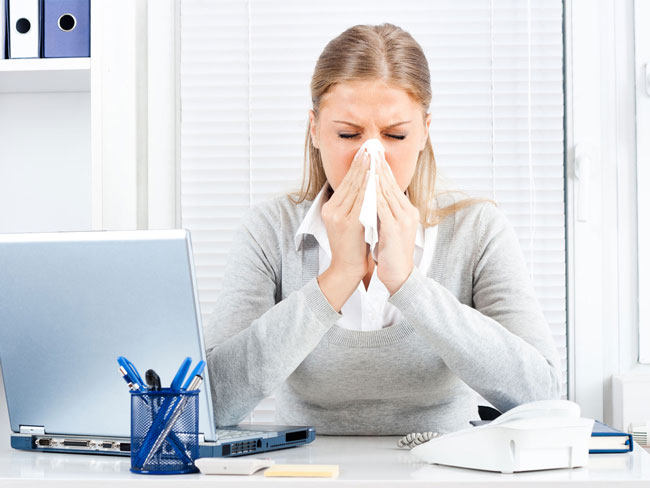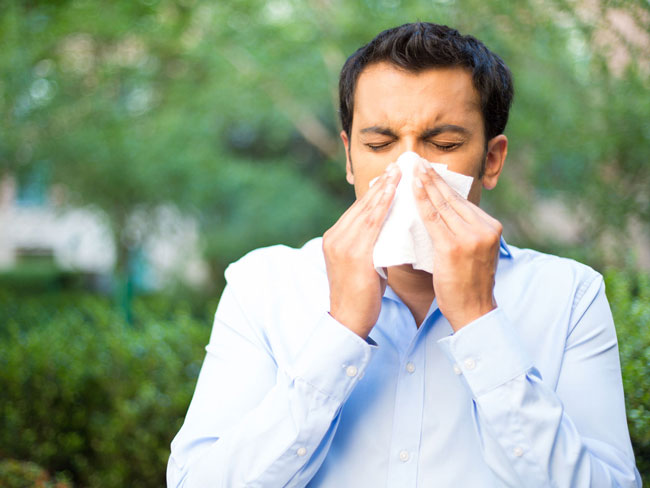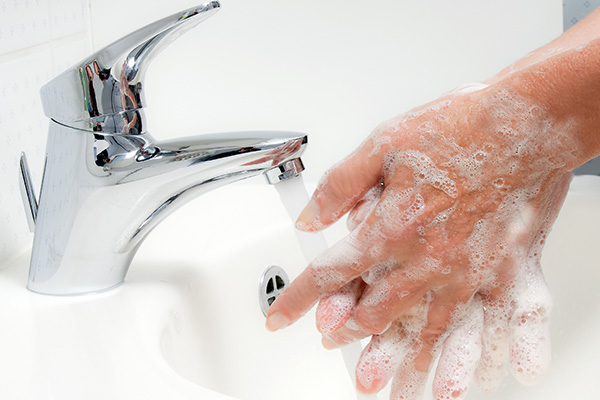Healthy Habits in the Workplace for Cold and Flu Season
- By Harrison Berry
- Reading Time: 4 mins.
It usually starts with a sore throat. Cue the runny nose and a cough. Is it the flu, or just a cold?
Tens of millions of Americans fall sick with one, the other, or both annually and spend days in bed instead of at school or work. Cold and flu season usually runs from December to February and causes tens of billions of dollars in economic damage. It also brings rattling coughs and wastebaskets full of used tissues—unwelcome heralds in every office.

Both the common cold and seasonal flu are easy to prevent and treat, especially if you practice healthy habits in the workplace. Here are some insights, tips, and tricks for keeping yourself and your team healthy and on task.
Cold or Flu: What’s the Difference?
To someone experiencing seasonal illness, the cold and flu can feel similar. Both cause nasal discharge, itchy throats, sneezing, fever, coughing, and aching muscles and joints. But that’s where the similarities end.
“The common cold is more of an annoyance,” Chicago-based pediatrician Dr. Ken Lyons told The FruitGuys. “When you have a cold, your immune system is getting taxed, and you can get an ear infection or pneumonia. … Influenza is a specific respiratory virus that can cause five to seven days of fevers, body aches, cough, chills. And the longer you’re sick, the more likely you are to get a secondary infection.”

Many different viruses can cause the common cold (aka rhinovirus) by infecting the sinuses, nose, and throat. The severity of illness can depend on the strain of the virus and the host’s immune system. According to the Cleveland Clinic, the average person contracts two to three colds per year. Because colds spread so easily, many measures to prevent illness can only provide partial coverage.
“There’s nothing to prevent the common cold,” Lyons said. “It’s mostly bad luck.”
The flu, or influenza, infects the upper respiratory system. It triggers a strong immune response, making it especially threatening for the very young, the old, and those with weakened immune systems or chronic illnesses. Like the cold, the flu can lead to serious secondary infections like pneumonia. It can also amplify pre-existing medical conditions like asthma and heart disease.
How to Prevent a Cold or Flu: The Shield
Practice these healthy habits in the workplace to keep yourself flu- and cold-free.
Mask Up
As the saying goes, an ounce of prevention is worth a pound of cure. Mask-wearing can help you avoid contracting or spreading respiratory illnesses by blocking the virus-carrying droplets expelled by coughing.
Get the Flu Vaccine
Medical professionals also strongly recommend the flu vaccine. Even if the vaccine doesn’t target the specific strain of the virus circulating in your area, it can still reduce the duration and severity of illness.
Wash Your Hands Regularly
The best protection is one of the simplest.
“The number one thing is just plain hand-washing,” Lyons said. “That’s number one and number two and number three. A lot of these germs spread by air and hand-to-hand contact.”
Boost Your Immune System
Lyons noted that “the jury’s out on [over-the-counter] vitamins” when it comes to combating the cold and flu. But, he said, supplements and a diet of foods with plenty of vitamins and nutrients—like Vitamin C-rich fresh fruit—can support a healthy immune system and speed up your recovery if you get sick.

Want farm-fresh fruit?
We've got you covered.How to Get Rid of a Cold or Flu: The Sword
Still got sick? Use these tactics to heal up and get back to work quickly.
Stay Home
When you feel the beginning of a scratchy throat and a fever, stay home from work or school to prevent others from getting sick, too. Hydration is essential, and water, vitamin-rich soups, and even popsicles can help you feel better and recover more quickly, according to the Mayo Clinic.
If you’re ill and you develop new or unusual symptoms like fever, call your doctor. People with the cold or flu are most contagious in the first few days of illness, and according to Lyons, it should be fine to return to the office after being fever-free for 24 hours.
Rest Up
Bedrest recharges the immune system and greatly affects recovery. According to Johns Hopkins Medicine, bedrest entails eight to ten hours of sleep per night—and abstinence from physical exercise.
Try Over-the-Counter Medication
Over-the-counter medicines may help reduce fever and promote uninterrupted sleep.
Office Etiquette for Cold and Flu Season
People contract viruses like the cold and flu when they’re close together in confined spaces, so the workplace is a prime spot for viruses to spread. To create a culture of personal hygiene and safety that protects everyone, encourage co-workers and employees to take sick leave when needed and promote hand-washing around the office.

Creating awareness around seasonal illness and implementing these healthy habits in the workplace will help your team understand the relationship between their own personal health and that of their colleagues.
“A lot of it is being cognizant,” Lyons said. “One thing that’s underrated is not going anywhere when you’re sick. Lay low. Feel free to stay home on a Friday night.”


